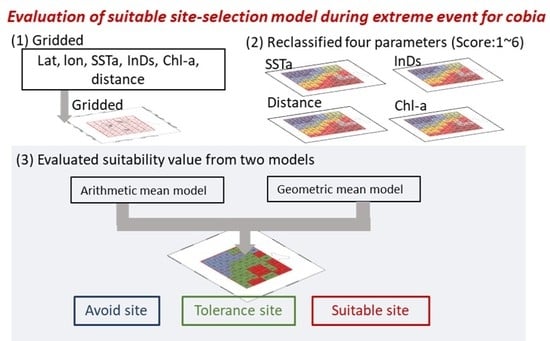Evaluating a Suitable Aquaculture Site Selection Model for Cobia (Rachycentron canadum) during Extreme Events in the Inner Bay of the Penghu Islands, Taiwan
Abstract
1. Introduction
2. Data and Methods
2.1. SST and Wind Speed Data Collected and Definition of Extreme Event
2.1.1. SST and Wind Speed Data
2.1.2. El Niño–Southern Oscillation
2.2. Environmental and Geographic Parameters
2.2.1. SST Anomalies
2.2.2. Cobia’s Tolerance for SST and the Cold-Water Intrusion Days
2.2.3. Chlorophyll-a Concentration
2.2.4. Offshore Distance from the PHI Coastline to the Center of the Grid
2.3. Suitable Aquaculture Site Selection Model during Extreme Events
2.3.1. Variable Influence Scores and Relative Weighting of Parameters
2.3.2. Evaluating Suitable Aquaculture Sites during Extreme Events
3. Results
3.1. Variations of 20 °C SST Isotherms in Wintertime around the PHI
3.2. Temporal Variations of SSTAs
3.3. Spatial Distribution of Environmental Parameters Ranked during Extreme Events
3.4. Evaluating the Suitable Aquaculture Sites of Cobia in the PHI
4. Discussion
5. Conclusions
Author Contributions
Funding
Acknowledgments
Conflicts of Interest
References
- The FAO Fisheries and Aquaculture Department. The State of World Fisheries and Aquaculture; Food and Agriculture Organization of the United Nations: Rome, Italy, 2012; pp. 3–5. [Google Scholar]
- Bondad-Reantaso, M.G.; Arthur, J.R.; Subasinghe, R.P. Understanding and Applying Risk Analysis in Aquaculture; Food and Agriculture Organization of the United Nations: Rome, Italy, 2008. [Google Scholar]
- Liu, Y.; Saitoh, S.I.; Radiarta, I.N.; Igarashi, H.; Hirawake, T. Spatiotemporal variations in suitable areas for Japanese scallop aquaculture in the Dalian coastal area from 2003 to 2012. Aquaculture 2014, 422, 172–183. [Google Scholar] [CrossRef]
- FAO. The State of World Fisheries and Aquaculture 2018; Food and Agriculture Organization of United Nations: Rome, Italy, 2018; p. 227. [Google Scholar]
- De Silva, S.S.; Soto, D. Climate change and aquaculture: Potential impacts, adaptation and mitigation. Climate change implications for fisheries and aquaculture: Overview of current scientific knowledge. FAO Fish. Aquac. Tech. Pap. 2009, 530, 151–212. [Google Scholar]
- Shaffer, R.V.; Nakamura, E.L. Synopsis of Biological Data on the Cobia Rachycentron canadum (Pisces: Rachycentridae); NOAA Technical Report NMFS; NOAA/National Marine Fisheries Service: Silver Spring, MD, USA, 1989.
- Ditty, J.G. Larval development, distribution, and ecology of cobia Rachycentron canadum (family: Rachycentridae), in the northern Gulf of Mexico. Fish. Bull. 1992, 96, 223–236. [Google Scholar]
- Liao, I.C.; Leano, E.M. Cobia Aquaculture: Research, Development and Commercial Production; Food and Agriculture Organization of the United Nations: Rome, Italy, 2007; pp. 131–145. [Google Scholar]
- Chang, Y.; Lee, K.T.; Lee, M.A.; Lan, K.W. Satellite Observation on the Exceptional Intrusion of Cold Water in the Taiwan Strait. Terr. Atmos. Ocean. Sci. 2009, 20. [Google Scholar] [CrossRef]
- Huang, T.S.; Lin, K.J.; Chen, C.C.; Tsai, W.S. Study on cobia, Rachycentron canadum, over-wintering using the indoor high-density recirculating system. J. Taiwan Fish Res. 2002, 10, 53–62. [Google Scholar]
- Huang, C.T.; Miao, S.; Farok, A. Economic analysis of cobia’s (Rachentron canadum) phase nursery stage culture in Taiwan. J. Fish Soc. Taiwan. 2008, 35, 117–130. [Google Scholar]
- Miao, S.; Jen, C.C.; Huang, C.T.; Hu, S.H. Ecological and economic analysis for cobia Rachycentron canadum commercial cage culture in Taiwan. Aquac. Int. 2009, 17, 125–141. [Google Scholar] [CrossRef]
- Sun, L.; Chen, H.; Huang, L.; Wang, Z.; Yan, Y. Growth and energy budget of juvenile cobia (Rachycentron canadum) relative to ration. Aquaculture 2006, 257, 214–220. [Google Scholar] [CrossRef]
- Jan, S.; Wang, J.; Chern, C.S.; Chao, S.Y. Seasonal variation of the circulation in the Taiwan Strait. J. Mar. Syst. 2002, 35, 249–2688. [Google Scholar] [CrossRef]
- Kuo, N.J.; Ho, C.R. ENSO effect on the sea surface wind and sea surface temperature in the Taiwan Strait. Res. Lett. 2004, 31. [Google Scholar] [CrossRef]
- Lee, M.A.; Yang, Y.C.; Shen, Y.L.; Chang, Y.; Tsai, W.S.; Lan, K.W.; Kuo, Y.C. Effects of an Unusual Cold-Water Intrusion in 2008 on the Catch of Coastal Fishing Methods around Penghu Islands, Taiwan. Terr. Atmos. Ocean. Sci. 2014, 25, 107–120. [Google Scholar] [CrossRef]
- Qiu, F.; Fang, W.; Fang, Y.; Guo, P. Anomalous oceanic characteristics in the South China Sea associated with the large-scale forcing during 2006–2009. J. Mar. Syst. 2012, 100, 9–18. [Google Scholar] [CrossRef]
- Radiarta, I.N.; Saitoh, S.I.; Miyazono, A. GIS-based multi-criteria evaluation models for identifying suitable sites for Japanese scallop (Mizuhopecten yessoensis) aquaculture in Funka Bay, southwestern Hokkaido, Japan. Aquaculture 2008, 284, 127–135. [Google Scholar] [CrossRef]
- Radiarta, I.N.; Saitoh, S.I. Biophysical models for Japanese scallop, Mizuhopecten yessoensis, aquaculture site selection in Funka Bay, Hokkaido, Japan, using remotely sensed data and geographic information system. Aquac. Int. 2009, 17, 403–419. [Google Scholar] [CrossRef]
- Saitoh, S.I.; Mugo, R.; Radiarta, I.N.; Asaga, S.; Takahashi, F.; Hirawake, T.; Shima, S. Some operational uses of satellite remote sensing and marine GIS for sustainable fisheries and aquaculture. ICES J. Mar. Sci. 2011, 68, 687–695. [Google Scholar] [CrossRef]
- Lee, M.A.; Yeah, C.D.; Cheng, C.H.; Chan, J.W.; Lee, K.T. Empirical orthogonal function analysis of AVHRR sea surface temperature patterns in Taiwan Strait. J. Mar. Sci. Technol. 2003, 11, 1–7. [Google Scholar]
- McClain, E.P.; Pichel, W.G.; Walton, C.C. Comparative performance of AVHRR-based multichannel sea surface temperatures. J. Geophys. Res. Oceans 1985, 90, 11587–11601. [Google Scholar] [CrossRef]
- Jan, S.; Chao, S.Y. Seasonal variation of volume transport in the major inflow region of the Taiwan Strait: The Penghu Channel. Deep-Sea Res. Part II-Top. Stud. Oceanogr. 2003, 50, 1117–1126. [Google Scholar] [CrossRef]
- Hsieh, H.J.; Hsien, Y.L.; Jeng, M.S.; Tsai, W.S.; Su, W.C.; Chen, C.A. Tropical fishes killed by the cold. Coral Reefs 2008, 27, 599. [Google Scholar] [CrossRef]
- Huang, B.; Banzon, V.F.; Freeman, E.; Lawrimore, J.; Liu, W.; Peterson, T.C.; Smith, T.M.; Thorne, P.W.; Woodruff, S.D.; Zhang, H.-M. Extended Reconstructed Sea Surface Temperature Version 4 (ERSST.v4). Part I: Upgrades and Intercomparisons. J. Clim. 2015, 28, 911–930. [Google Scholar] [CrossRef]
- Ueng, P.S.; Yu, S.L.; Tzeng, J.J.; Ou, C.H. The effect of water temperature on growth rate of cobia Rachycentron canadum in Penghu. In Proceedings of the 6th Asian Fisheries Forum, Kaohsiung, Taiwan, 25–30 November 2001. [Google Scholar]
- Kirby-Smith, W.W.; Barber, R.T. Suspension-feeding aquaculture systems: Effects of phytoplankton concentration and temperature on growth of the bay scallop. Aquaculture 1974, 3, 135–145. [Google Scholar] [CrossRef]
- Theobald, D.M.; Norman, J.B.; Peterson, E.; Ferraz, S.; Wade, A.; Sherburne, M.R. Functional Linkage of Water Basins and STREAMS (FLoWS) v1 User’s Guide: ArcGIS Tools for Network-Based Analysis of Freshwater Ecosystems; Natural Resource Ecology Lab, Colorado State University: Fort Collins, CO, USA, 2006; p. 43. [Google Scholar]
- Wold, S.; Sjöström, M.; Eriksson, L. PLS-regression: A basic tool of chemometrics. Chemom. Intell. Lab. Syst. 2001, 58, 109–130. [Google Scholar] [CrossRef]
- Carrascal, L.M.; Galván, I.; Gordo, O. Partial least squares regression as an alternative to current regression methods used in ecology. Oikos 2009, 118, 681–690. [Google Scholar] [CrossRef]
- Kapetsky, J.M.; McGregor, L.; Nanne, E.H. Geographical Information System and Satellite Remote Sensing to Plant for Aquaculture Development; Food and Agriculture Organization of the United Nations: Rome, Italy, 1987. [Google Scholar]
- Meaden, G.J. Geographical Information Systems and Remote Sensing in Inland Fisheries and Aquaculture; No. F009. 048; FAO: Rome, Italy, 1991. [Google Scholar]
- Legeckis, R. A survey of worldwide sea surface temperature fronts detected by environmental satellites. J. Geophys. Res. 1978, 83, 4501–4522. [Google Scholar] [CrossRef]
- Hosoda, K. A review of satellite-based microwave observation of sea surface temperature. J. Oceanogr. 2010, 66, 439–473. [Google Scholar] [CrossRef]
- Lee, M.A.; Chang, Y.; Lee, K.T.; Chan, J.W.; Liu, D.C.; Su, W.C. A satellite and field view of the winter SST variability in the Taiwan Strait. In Proceedings of the 2005 IEEE International Geoscience and Remote Sensing Symposium, IGARSS′05, Seoul, Korea, 29 July 2005; pp. 2621–2626. [Google Scholar]
- Gentemann, C.L.; Donlon, C.J.; Stuart-Menteth, A.; Wentz, F.J. Diurnal signals in satellite sea surface temperature measurements. Geophys. Res. Lett. 2003, 30, 30. [Google Scholar] [CrossRef]
- Perez, O.M.; Telfer, T.C.; Ross, L.G. Geographical information systems-based models for offshore floating marine fish cage aquaculture site selection in Tenerife, Canary Islands. Aquac. Res. 2005, 36, 946–961. [Google Scholar] [CrossRef]
- Liao, E.; Jiang, Y.; Li, L.; Hong, H.; Yan, X. The cause of the 2008 cold disaster in the Taiwan Strait. Ocean Model 2013, 62, 1–10. [Google Scholar] [CrossRef]
- Tzeng, M.T.; Lan, K.W.; Chan, J.W. Interannual variability of wintertime sea surface temperatures in the eastern Taiwan Strait. J. Mar. Sci. Technol. Taiwan 2012, 20, 707–712. [Google Scholar]
- Zhang, R.-H.; Rothstein, L.M.; Busalacchi, A.J. Origin of upper-ocean warming and El Nino change on decadal scales in the tropical Pacific Ocean. Nature 1998, 391, 879–883. [Google Scholar] [CrossRef]
- Newman, M.; Compo, G.P.; Alexander, M.A. ENSO-forced variability of the Pacific decadal oscillation. J. Clim. 2003, 16, 3853–3857. [Google Scholar] [CrossRef]
- Wu, C.R. Interannual modulation of the Pacific Decadal Oscillation (PDO) on the low-latitude western North Pacific. Prog. Oceanogr. 2013, 110, 49–58. [Google Scholar] [CrossRef]
- Cheng, Y.H.; Chang, M.H. Exceptionally cold water days in the southern Taiwan Strait: Their predictability and relation to La Niña. Nat. Hazards Earth Syst. Sci. 2018, 18. [Google Scholar] [CrossRef]
- Chang, Y.; Shimada, T.; Lee, M.A.; Lu, H.J.; Sakaida, F.; Kawamura, H. Wintertime sea surface temperature fronts in the Taiwan Strait. Geophys. Res. Lett. 2006, 33. [Google Scholar] [CrossRef]
- Shih, Y.C. Integrated GIS and AHP for marine aquaculture site selection in Penghu Cove in Taiwan. J. Coast. Zone Manag. 2017, 20, 438. [Google Scholar] [CrossRef]
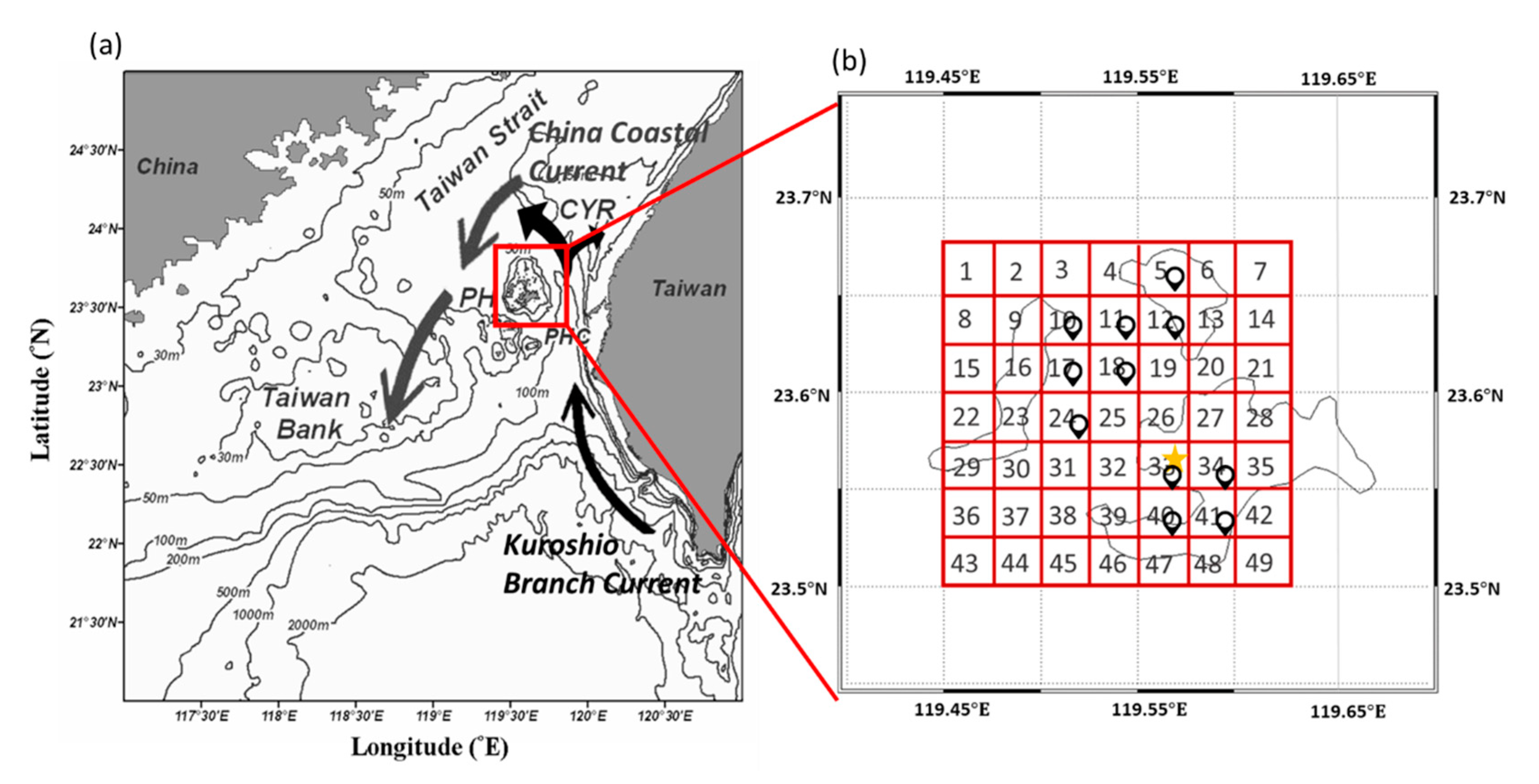
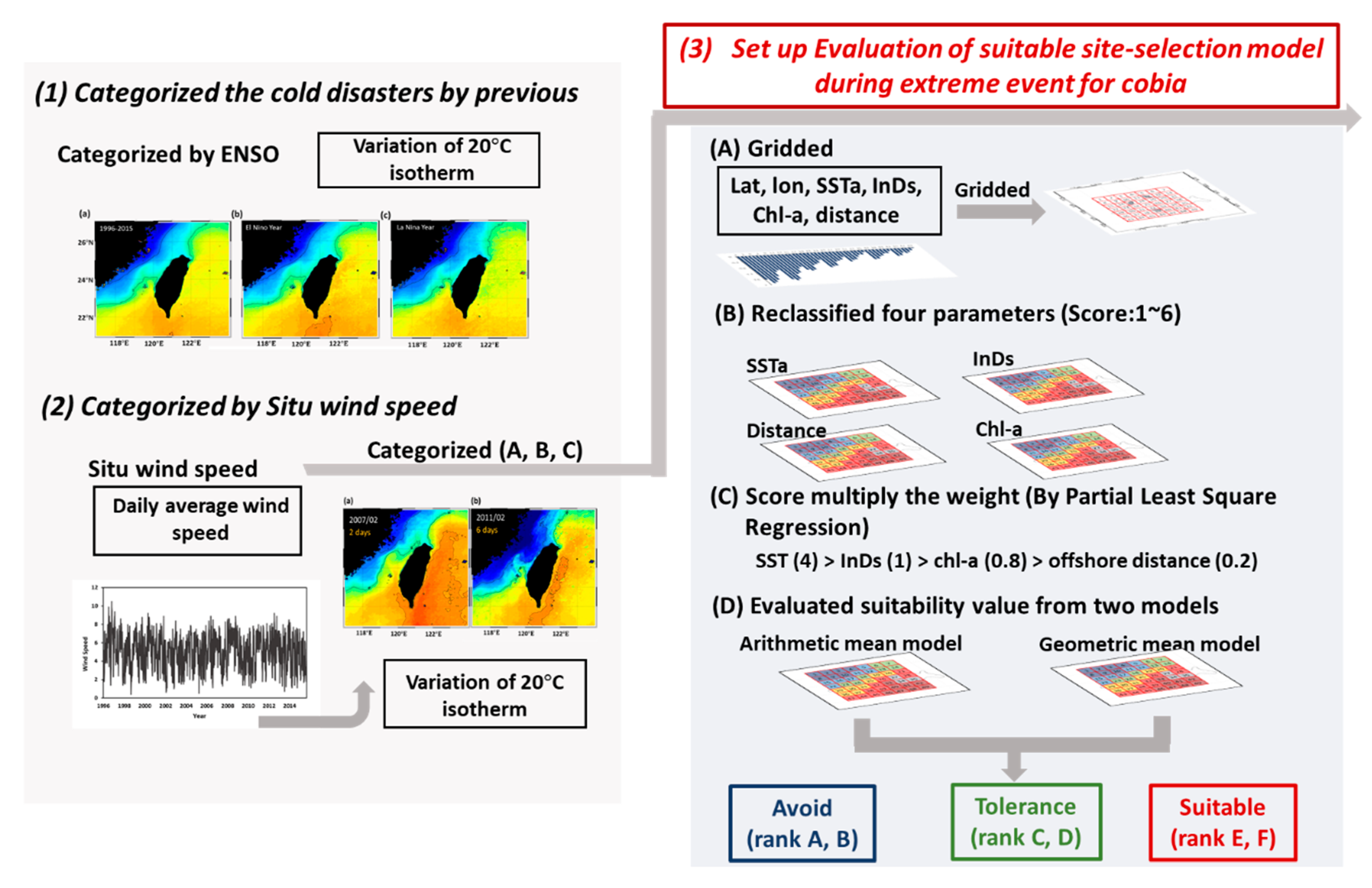
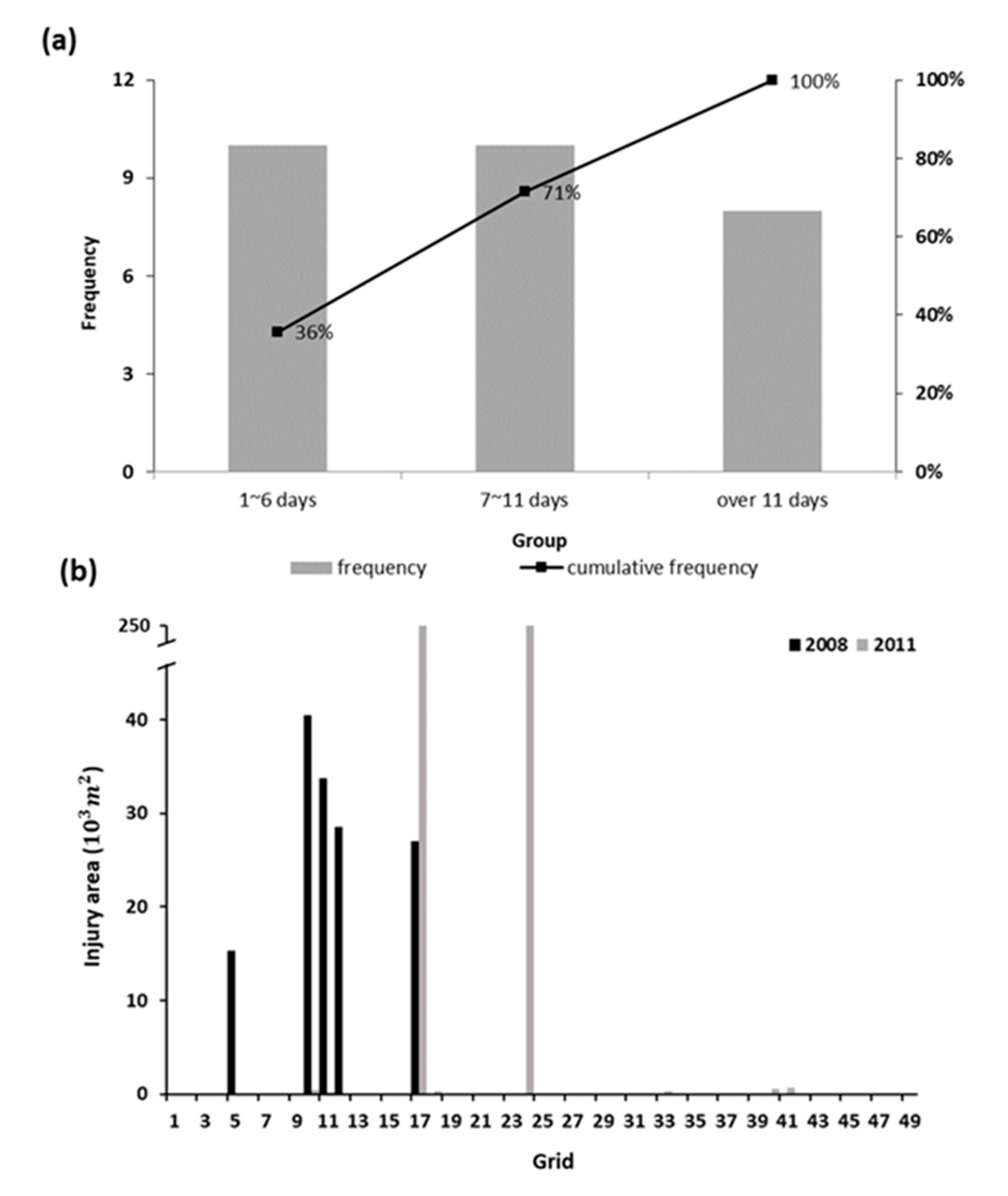
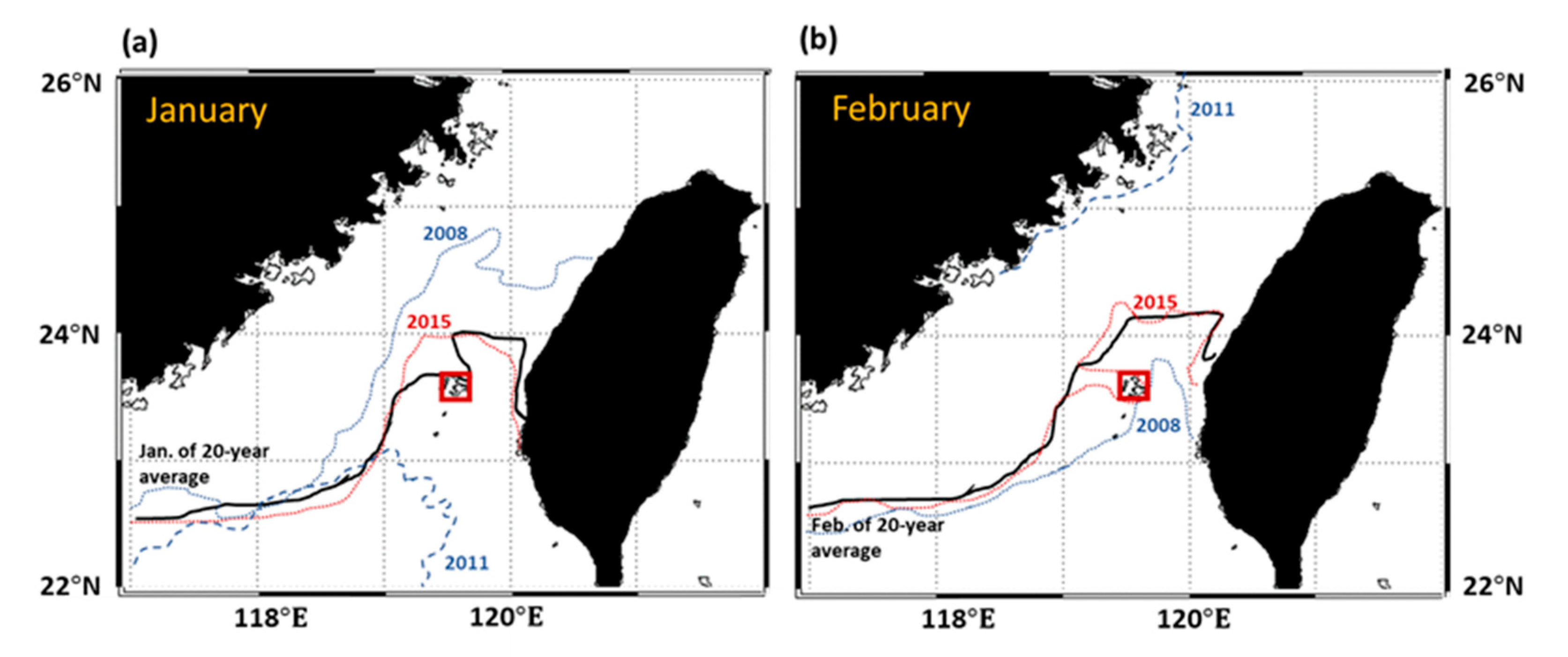
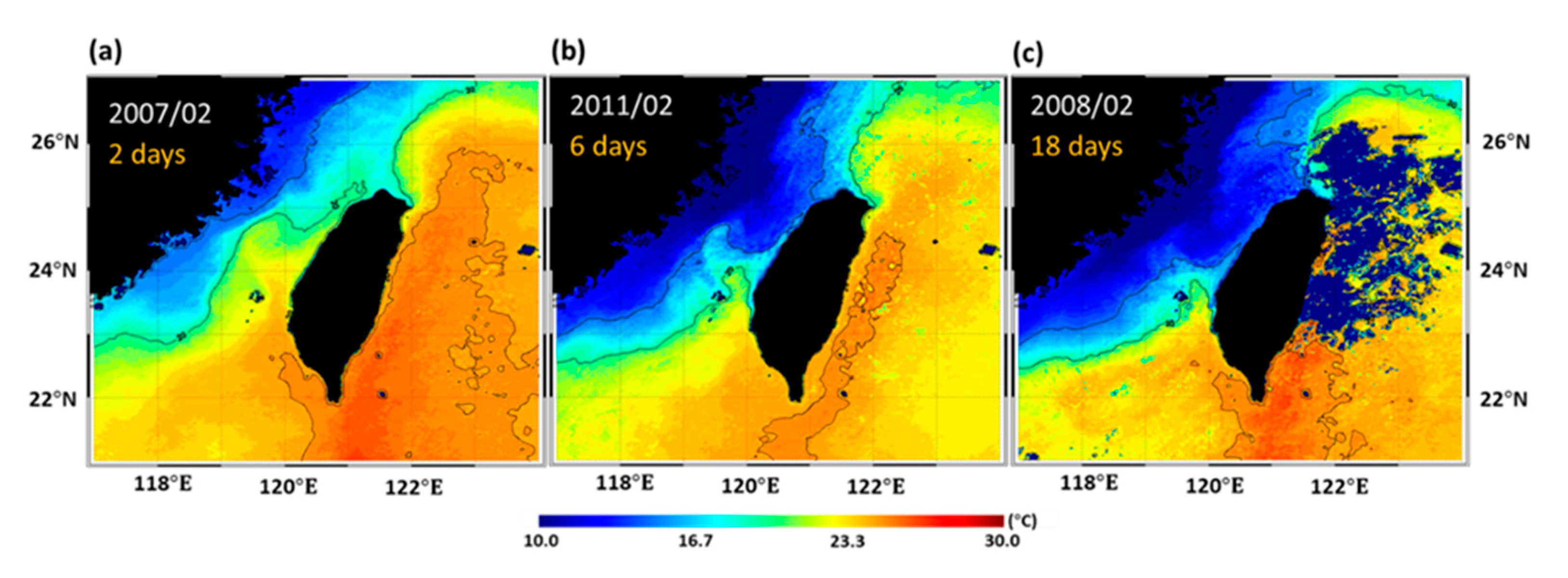
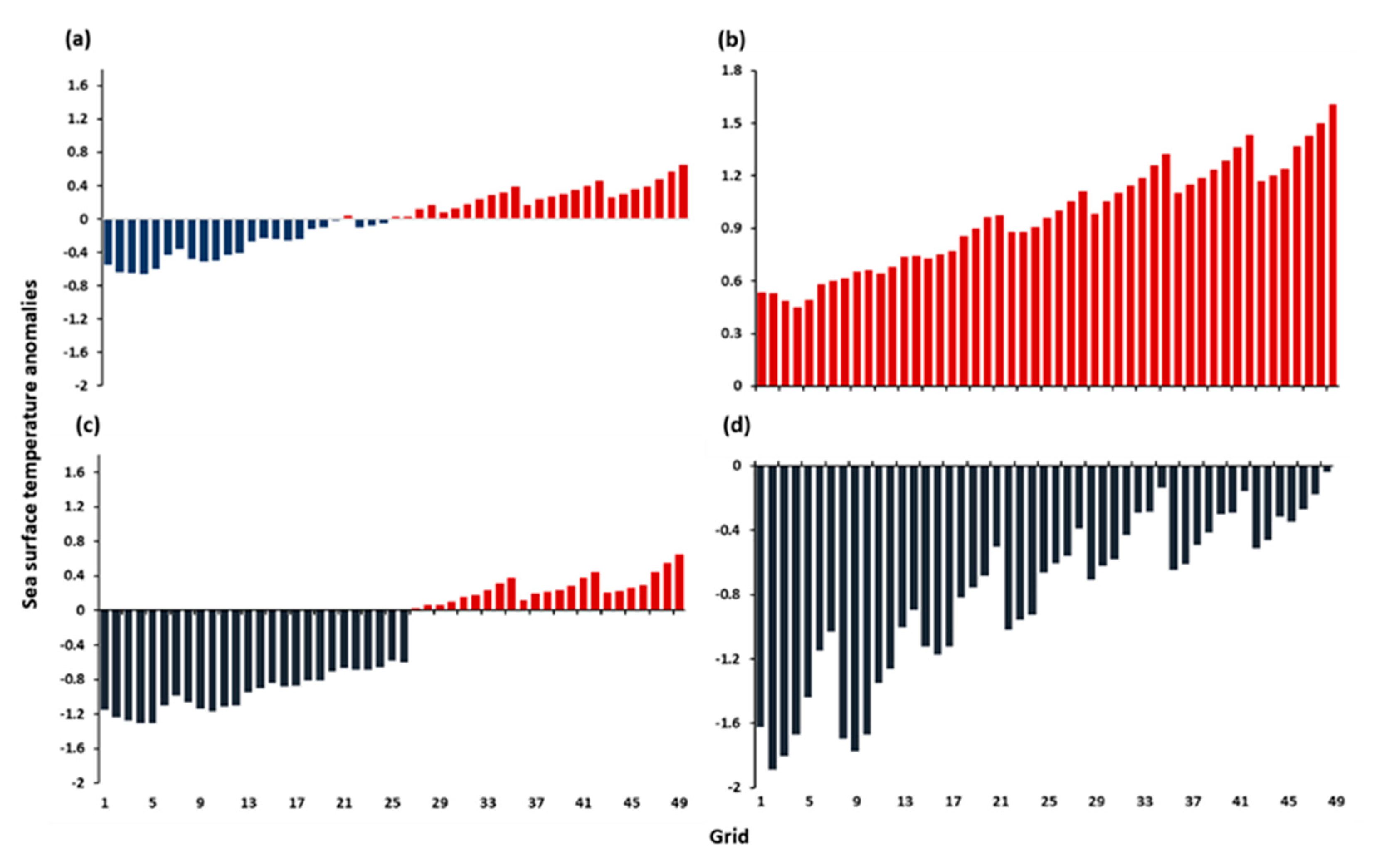
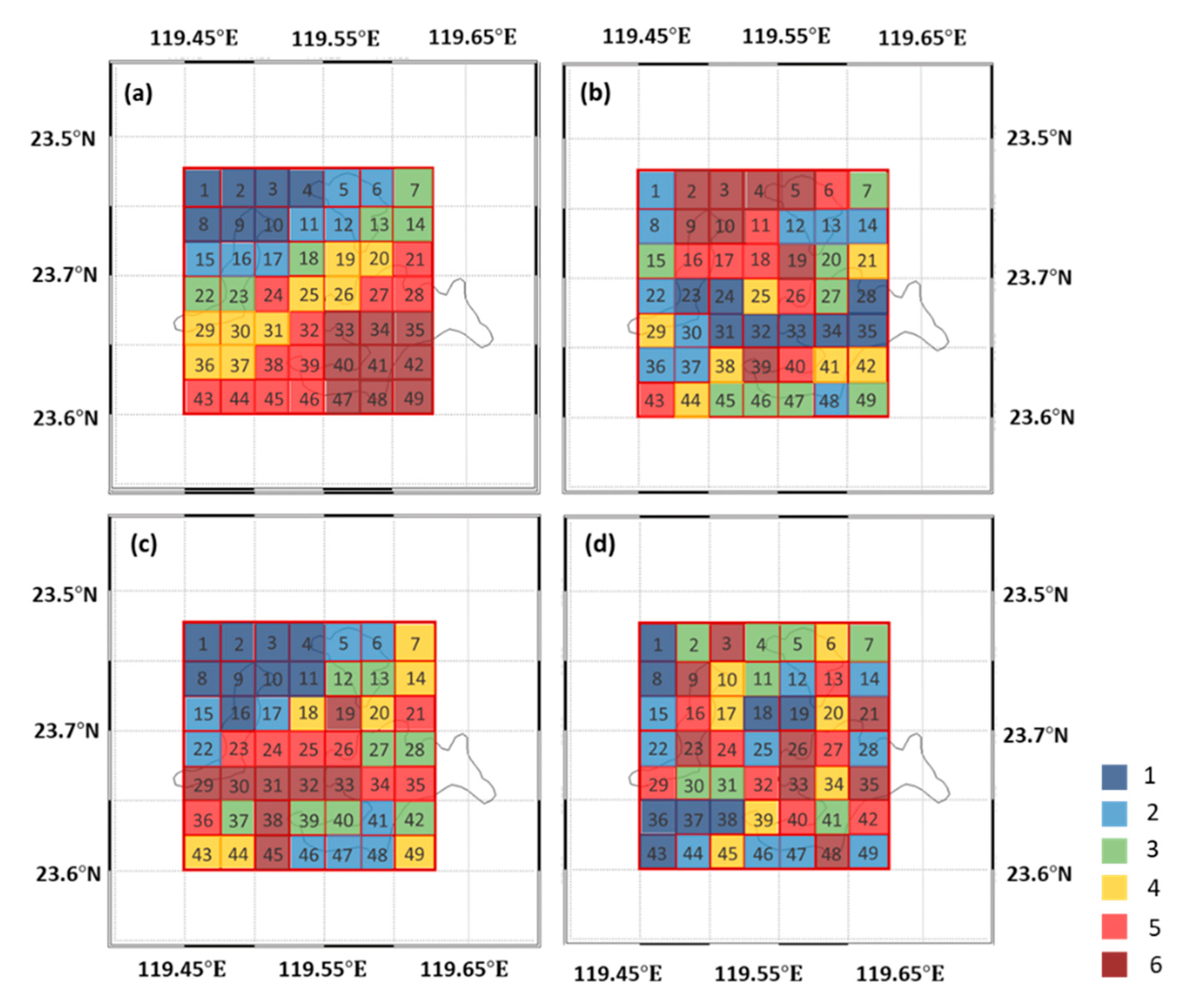

| Parameter | 6 | 5 | 4 | 3 | 2 | 1 |
|---|---|---|---|---|---|---|
| Sea surface temperature anomalies | 0.78~0.49 | 0.49~0.23 | 0.23~−0.08 | −0.08~−0.3 | −0.3~−0.8 | −0.8~−1.08 |
| Cold water intrusion day | 8 | 9 | 10 | 11 | 12 | 13-16 |
| Chlorophyll a | 1.4~1.35 | 1.35~1.33 | 1.33~1.32 | 1.32~1.30 | 1.30~1.28 | 1.28~1.24 |
| Distance to coastal line | 20~180 | 190~430 | 430~600 | 600~1260 | 1260~2300 | 2300~3900 |
| Category | Year | Month | Average SST | Strong Wind Speed | ENSO Event |
|---|---|---|---|---|---|
| A | 2002 | 1 | 22.68 | 4 | Normal year |
| 2002 | 2 | 21.50 | 3 | Normal year | |
| 2003 | 2 | 20.76 | 5 | El Nino (Moderate) | |
| 2007 | 2 | 19.24 | 2 | El Nino (Weak) | |
| 2009 | 2 | 20.71 | 3 | Normal year | |
| 2010 | 1 | 20.69 | 6 | El Nino (Moderate) | |
| 2010 | 2 | 21.36 | 6 | El Nino (Moderate) | |
| 2011 | 2 | 14.75 | 6 | La Nina (Strong) | |
| 2014 | 2 | 20.45 | 5 | El Nino (Weak) | |
| 2015 | 2 | 20.22 | 4 | El Nino (Strong) | |
| B | 2003 | 1 | 20.35 | 9 | El Nino (Moderate) |
| 2004 | 1 | 19.60 | 10 | El Nino (Weak) | |
| 2004 | 2 | 20.16 | 9 | El Nino (Weak) | |
| 2005 | 1 | 18.23 | 11 | La Nina (Weak) | |
| 2005 | 2 | 17.24 | 8 | La Nina (Weak) | |
| 2006 | 1 | 16.88 | 10 | Normal year | |
| 2013 | 1 | 21.31 | 11 | Normal year | |
| 2013 | 2 | 18.79 | 9 | Normal year | |
| 2014 | 1 | 20.64 | 8 | El Nino (Weak) | |
| 2015 | 1 | 19.47 | 8 | El Nino (Strong) | |
| C | 2006 | 2 | 19.80 | 12 | Normal year |
| 2007 | 1 | 21.92 | 14 | El Nino (Weak) | |
| 2008 | 1 | 20.94 | 14 | La Nina (Strong) | |
| 2008 | 2 | 17.91 | 18 | La Nina (Strong) | |
| 2009 | 1 | 21.97 | 13 | Normal year | |
| 2011 | 1 | 18.15 | 20 | La Nina (Strong) | |
| 2012 | 1 | 17.30 | 13 | La Nina (Moderate) | |
| 2012 | 2 | 17.06 | 13 | La Nina (Moderate) |
© 2020 by the authors. Licensee MDPI, Basel, Switzerland. This article is an open access article distributed under the terms and conditions of the Creative Commons Attribution (CC BY) license (http://creativecommons.org/licenses/by/4.0/).
Share and Cite
Wu, Y.-L.; Lee, M.-A.; Chen, L.-C.; Chan, J.-W.; Lan, K.-W. Evaluating a Suitable Aquaculture Site Selection Model for Cobia (Rachycentron canadum) during Extreme Events in the Inner Bay of the Penghu Islands, Taiwan. Remote Sens. 2020, 12, 2689. https://doi.org/10.3390/rs12172689
Wu Y-L, Lee M-A, Chen L-C, Chan J-W, Lan K-W. Evaluating a Suitable Aquaculture Site Selection Model for Cobia (Rachycentron canadum) during Extreme Events in the Inner Bay of the Penghu Islands, Taiwan. Remote Sensing. 2020; 12(17):2689. https://doi.org/10.3390/rs12172689
Chicago/Turabian StyleWu, Yan-Lun, Ming-An Lee, Lu-Chi Chen, Jui-Wen Chan, and Kuo-Wei Lan. 2020. "Evaluating a Suitable Aquaculture Site Selection Model for Cobia (Rachycentron canadum) during Extreme Events in the Inner Bay of the Penghu Islands, Taiwan" Remote Sensing 12, no. 17: 2689. https://doi.org/10.3390/rs12172689
APA StyleWu, Y.-L., Lee, M.-A., Chen, L.-C., Chan, J.-W., & Lan, K.-W. (2020). Evaluating a Suitable Aquaculture Site Selection Model for Cobia (Rachycentron canadum) during Extreme Events in the Inner Bay of the Penghu Islands, Taiwan. Remote Sensing, 12(17), 2689. https://doi.org/10.3390/rs12172689





